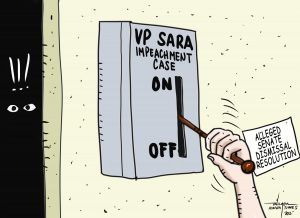February is the month we celebrate Chinese New Year and Valentine’s Day and these two celebrations are associated with the color red.
Red in Chinese New Year signifies good fortune, luck, vitality, celebration and prosperity. It also wards off evil spirits.
Red on Valentine’s Day symbolizes love, passion, and desire. It is the color of blood and the heart.
Other meanings associated with the color red are courage, sacrifice, danger, state of emergency. Code red means there is a fire.
If we are at war, the red part of our flag will be the one on top. And when we generally “red flag” something or someone, it means we are identifying or drawing attention to a problem or an issue that must be dealt with.
For American stores, a “red tag” usually means a clearance sale and these items must go (they are getting rid of old stocks). In the Philippines, a “red tag” is a label used to accuse individuals or groups and organizations for being left-leaning, subversives, communists, or terrorists.
When we talk about “red tape” it is the negative impact of too many regulations and processes that take too much time than make sense.
I like Merriam-Webster’s definition: “Red tape is official routine or procedure marked by excessive complexity which results in delay or inaction.”
Whenever we are confronted with too much paperwork in the private sector, we would often remark: “Para man din itong gobyerno!” (This is just like dealing with government.)
Because delays and too many rules and regulations are always associated with the government bureaucracy.
I was listening the other day to former National Security Adviser Clarita Carlos share in a Senate committee hearing the story of how long it takes for one government agency to have one leaky faucet that costs around 200 pesos replaced — four months and 26 signatures.
It is absurd, I know. But that’s how it works. Or not work.
And we wonder. If we have so many rules and procedures to follow, how come there are still a lot of public funds being stolen in big amounts on a regular basis? How did those plundering occur when merely buying a 200-peso faucet involved 26 signatures to process? How do they expedite the process of getting millions of pesos without the proper documentation?
Also they require at least three copies of every document being processed, where do they store those paperwork? How many buildings do they have to build to keep all those files they require us to submit? Who keeps track of these things? And how come when it is time to prosecute graft and corruption cases there seem to be no paper trail to show as evidence?
Speaking of prosecutions, I noticed also that private banks are starting to act like prosecutors when you transact business with them. When you deposit a significant amount, they ask you where you got the money. And when you try to withdraw your money, they ask you where you will use the money. As if every client is assumed a money launderer until proven otherwise.
And yet we still hear a lot of shady transactions being done by actual money launderers and illegal businesses on the news that the banks fail to keep track of.
Looks like there are special procedures with a different color code for plunderers and criminals and then there is just red tape for the rest of us.
It does not just happen in procurement or anything that involves money, it happens everywhere. Like in health forms that we have to fill out.
Recently, I needed to undergo RT-PCR test as a requirement for watchers of patients admitted in the hospital. I had to fill out the same three pages of paperwork they ask for at the height of the pandemic requiring information no longer relevant to the current situation.
When I asked the hospital why they are still asking us to go through all that, the reply was: “It is the Department of Health that requires us to do that.” When I asked why they have not at least changed the form and streamlined it, they said: “We do not know.”
And that’s the problem right there. We do not know why we do the things we do. “It has always been done this way,” is the reason given. Nobody bothers anymore to ask if they are still relevant or even needed at all.
Another annoying practice they do in government offices is asking every person to sign in a logbook, leave an ID, explain the purpose of your visit and the person you are seeing. Why? What do they do with all that information? Who makes the report and for what purpose? Do they compile the data daily, weekly, monthly? Will that knowledge help them improve their service? Will that be worth all the trouble people go through? And can they find a better way?
So you spend all that time filling out forms, producing all the supporting documents listed, making several copies, and then when it is your turn at the counter, you still are not sure they will be processed because of any or all of the following: (a) you lack one more thing that is not on the list and was added only last week and you did not get the memo; (b) the one who can decide on your case is not around; (c) your documents are still for review by someone else who may or may not be around (they cannot tell you definitely); (d) the form you used is an old one; (e) there is a new law and the implementing rules and regulations are still being crafted so all these may change; (f) all their processing must now be done online.
We are talking here of the usual daily routine transactions in government offices. Yet our political leaders are making us believe we can change the Philippine Constitution in a few easy steps for a short period of time.
Again, there is a different and expedited process for the privileged few. The red tape is just for the rest of us.
The torture of having to deal with red tape is terrorizing that it must be red-tagged and the time and energy wasted must be red-flagged. And like the clearance sale marked with red tags, it must go now.



